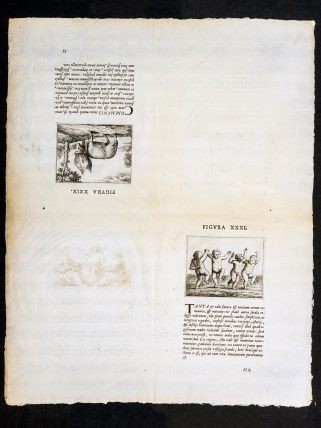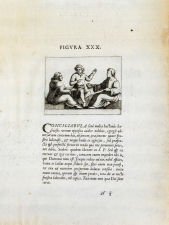
A BOOK UNFINISHED: PARACELSUS IN HAND-PRESS SHEETS
By Stephen Greenberg
Books today, as physical objects, have reached a very odd place in our consciousness. Readers are increasingly offered books (or at least texts—there is a difference: books are physical objects; texts are their intellectual contents) in a bewildering array of electronic alternatives. Print (on paper) is dead, we are told, at the same time that the latest Harry Potter story sold two million print copies in the United States and Canada in its first two days of availability.
Moreover, at no time in the history of printing has it been easier to produce a physical book. Websites such as Blurb.com and Lulu.com allow authors to self-publish books in a variety of formats, with drag-and-drop interfaces, fast turnover times, and remarkably good results. Self-publishing is hardly new, but modern technology allows for extremely small press-runs; even as small as a single copy.

A full sheet of the Prognosticatio from a hand-press showing the preface and three other pages of text, 1610
This is NOT how it was. During the hand-press era of Western printing (roughly 1450 to the early 19th century), books were laboriously created with hand-set type, on single sheets of hand-made paper, with clumsy wooden (eventually iron) presses operated by human muscle. Although there were exceptions in special cases, a press run needed to be about 1500 copies for anyone (author, printer, or publisher) to make any money. The large sheets of paper were printed on one side, allowed to dry, printed on the other side (the technical term was “perfecting”) allowed to dry again, folded, gathered, stitched, and (possibly) bound for sale. None of this work was mechanized until well into the 19th century.
It is exceedingly rare to see an original hand-press book in an intermediate stage of production. But in the collections of the National Library of Medicine, there exists just such a book: printed sheets from 1610, never folded, never bound, never quite finished. It is entitled Prognosticatio Eximii Doctrois Theophrasti Paracelsi, which translates (roughly) from the Latin as predictions or prophecies from the famous doctor, pharmacologist, alchemist, astrologer, and much else, Philippus Aureolus Theophrastus Bombastus von Hohenheim (1493–1541), normally just known as Paracelsus. His work in toxicology, particularly involving the medical uses of mercury, was groundbreaking. His philosophical and mystical work, particularly as shown in this book, which was reprinted many times, simply demonstrates how flexible the boundaries were between science and medicine at the time.
The Prognosticatio consists of ten sheets, roughly 47×38 centimeters (18.5×15 inches) each, of handmade paper just as it would have emerged from the press after the second side was printed. Four pages of text and illustrations are visible on each side of the sheet; their orientation depending on how the sheet was to be folded. In this case, the sheet was to be folded twice, to provide a quarto-format gathering of eight pages. Had the sheet shown two pages per side, designed to be folded once, it would have been a folio; had it been printed with eight pages showing, designed the be folded three times, it would have been an octavo. It’s worth remembering that the terms folio, quarto, octavo, and so on refer to how the sheet was to be folded after printing. They have no direct bearing on the size of the book itself in the hand-press era.
Often, printed sheets would have additional letters called “signatures” in the lower margins to help the bookbinder place the gatherings in the correct order for sewing. This would be especially important when gatherings were to be nested inside each other, a common type of book structure. The main advantage of such nesting was that it needed less sewing to put the book together; the disadvantage was that it made the job of typesetting more complicated, as the text needed to be oriented just right over multiple settings of type. Both systems were commonly used. In this book it is clear, based on the signature letters, that nesting was not used. The letters also indicate that the book is complete, as there are no gaps in the letter order.
The Prognosticatio does, however, present one additional complication. It is profusely illustrated with obscure, if interesting, mystical pictures. In this edition, they are copperplate engravings. The engravings are beautifully done, and clearly added meaning to the text (for those in the know), but for the printer, they added another layer of complexity to the production. For technical reasons, the copperplates needed to go through a different sort of press for printing. Earlier editions were illustrated with woodcuts, which did not present this problem, but were also inferior in quality to the engravings. For the printer, including engravings meant that each sheet of paper went through presses four times: once on each side for the image, and once on each side for the text.
It will never be known why this copy was left uncompleted. Presumably, it simply didn’t sell. Sheets could bound at the time of sale, or folded and stitched without binding, or even sold loose and unfolded, with the purchaser taking responsibility for the finishing. However, someone must have thought the sheets worth keeping. There were many other uses to which waste sheets could be put by either the printer or the bookbinder.
For more information about this book and other collections, please contact the History of Medicine Division at hmdref@mail.nih.gov.





























No hay comentarios:
Publicar un comentario